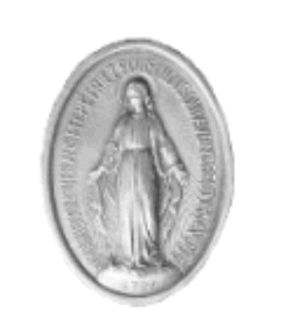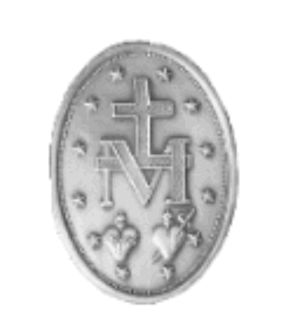Miraculous Medal
Miraculous Medal
The Miraculous Medal
— Reverend Matthew R. Mauriello

The medal of the Immaculate Conception is more popularly known as the Miraculous Medal. It was designed by the Blessed Virgin Mary who manifested the design of the medal to a young novice of the Daughters of Charity in the Chapel of the Motherhouse, 140 Rue du Bac, Paris, France.
Zoe Laboure was born in 1806 and entered the religious congregation founded by St. Vincent de Paul at the age of twenty-four in April of 1830 and took the name Catherine. The first apparition of Our Lady took place three months later on July 18 at 11:30 p.m. Seated in the sisters' chapel, the Blessed Virgin told Sister Catherine that she had been chosen for a special mission for the glory of God. It would bring much suffering, but would also bring abundant graces to many.
On November 27, 1830, the Blessed Virgin Mary appeared to the young novice a second time. Mary was beautifully robed, standing on a globe, half visible. In her hands, Mary held another globe representing the world. Suddenly this globe disappeared and on Our Lady's fingers were many rings with precious stones. From these gems came rays of light shining on all sides. Mary then explained to her: The globe represents the whole world and every single person. The rays are the symbols of the graces I shed upon those who ask for them.
There was a frame formed around the Blessed Virgin within which was written in letters of gold this prayer: "O Mary, conceived without sin, pray for us who have recourse to thee." The novice then heard a voice: "Have a medal struck according to this model. All who wear it will receive great graces; they should wear it around the neck." The tableau seemed to turn and on the reverse side, Sister Catherine saw the letter M surmounted by a bar and a cross; beneath this were the hearts of Jesus and Mary, the one crowned with thorns and the other pierced with a sword.
When Sister Catherine related this vision to her confessor, Fr. Aladel, he asked her if there was to be any writing on the reverse of the medal. He told her to ask the Blessed Virgin what to put there. The sister obeyed and prayed to Our Lady for an answer. One day during her meditation, the Blessed Virgin responded with a voice which said, "the M and the two hearts express enough."
With the approval of Monsignor de Quelen, Archbishop of Paris, the first Fifteen-hundred medals representing this vision were struck and issued in June 1832 and many conversions resulted from their spread abroad. The most striking among these was the conversion of Alphonse Ratisbonne, which took place in Rome in 1842. Although he was Jewish, he reluctantly agreed to wear the medal, received a vision of Our Lady and founded a religious congregation after his conversion. On account of these wonderful conversions and other miracles, the medal has come to be known as the 'Miraculous Medal'.
The young novice obeyed the directives of her confessor to keep secret her identity as the person to whom Our Lady had manifested the medal. She died forty-six years later on December 31, 1876 and was beatified by Pope Pius XI in 1933 and canonized by Pope Pius XII in 1947. The Feast of St. Catherine Laboure is kept on November 28 each year, the day after the Feast of the Manifestation of the Miraculous Medal on November 27.

The above article appeared in the Fairfield County Catholic January 1996. Reprinted with permission of the author and publisher.
All About Mary includes a variety of content, much of which reflects the expertise, interpretations and opinions of the individual authors and not necessarily of the Marian Library or the University of Dayton. Please share feedback or suggestions with marianlibrary@udayton.edu.
